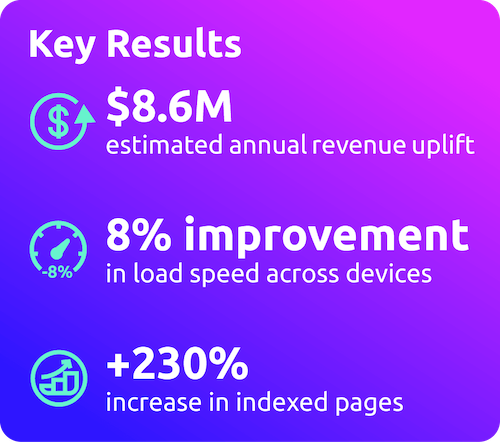Summary
A leading U.S. auto parts retailer, recognized for its extensive product catalog and direct-to-consumer business model, was facing growing challenges with site performance and indexation. Despite significant investments in performance optimization, their Core Web Vitals consistently showed failures, limiting growth potential and exposing them to competitive SEO risk.
By implementing Harper’s Early Hints technology in a proof-of-concept (POC), the retailer achieved measurable gains: faster load times, dramatically improved page indexation, and strong leading indicators of revenue uplift. With minimal code changes and a rapid rollout, the results built a compelling business case for scaling performance enhancements across their digital ecosystem.
Context
This retailer manages one of the largest online catalogs in its industry, with millions of unique products and information pages. As customer journeys increasingly began with organic search, site efficiency became a mission-critical factor.
Despite ongoing engineering work, Core Web Vitals (CWVs) consistently underperformed. Google Search Console showed that nearly all URLs were failing or needed improvement across both desktop and mobile. While the site still generated substantial revenue, the lack of CWV “green” scores represented a glass ceiling: further digital marketing spend was yielding diminishing returns, and organic growth potential remained capped.
The leadership team recognized that without a material shift in performance, future revenue growth would stagnate.

The Problem
- Core Web Vitals failures: Virtually all URLs were flagged as failing or needing improvement.
SEO growth limits: Even with significant ad spend, organic visibility lagged competitors. - Indexation inefficiency: Large portions of the catalog weren’t being surfaced by Google, leaving revenue on the table.
- Risk of stagnation: Growth was plateauing despite ongoing marketing and infrastructure investments.
The Solution: Early Hints
Harper partnered with the retailer to run a focused 30-day proof-of-concept test on the retailer’s production website. The goal was to validate whether Early Hints—a distributed edge capability that preloads critical assets using HTTP 103—could materially accelerate site speed and improve search engine responsiveness.
Crucially, this required no code refactoring by the client. The solution was activated through platform configuration, allowing Harper’s distributed cloud platform to accelerate time-to-first-byte and largest contentful paint across all browsers and devices.
Within days, the results were clear: Early Hints provided not just performance gains, but measurable business impact.
The Outcome
The proof of concept generated an immediate uplift across both user experience and search visibility:
- Page load speed improved by 8%, cutting average load times by 280ms.
- Largest Contentful Paint (LCP) improved significantly, moving the retailer closer to “good” thresholds on mobile and desktop.
- Page indexation surged 230% in just 15 days, moving millions of “crawled not indexed” pages into the live Google SERPs index.
- Estimated revenue benefit: $8.6M annually, based on conservative industry benchmarks linking performance improvements to conversion rates.
These results validated that even small gains in speed can translate into disproportionate business outcomes for large-scale e-commerce sites. Importantly, the impact extended beyond Core Web Vitals to leading indicators such as crawl rates, impressions, and traffic growth.
Conclusion & Path Forward
The POC demonstrated that Early Hints can unlock hidden growth for retailers managing massive catalogs. For this auto parts leader, the acceleration of page loads led directly to better indexation, more impressions, and higher revenue potential.
While Early Hints delivered immediate wins, the next stage involves building on this momentum: implementing prerendering, advanced caching, and phased infrastructure enhancements. Each step moves the retailer closer to sustained Core Web Vitals “green” scores—ensuring long-term competitiveness in organic search and continued revenue growth.







.jpg)
